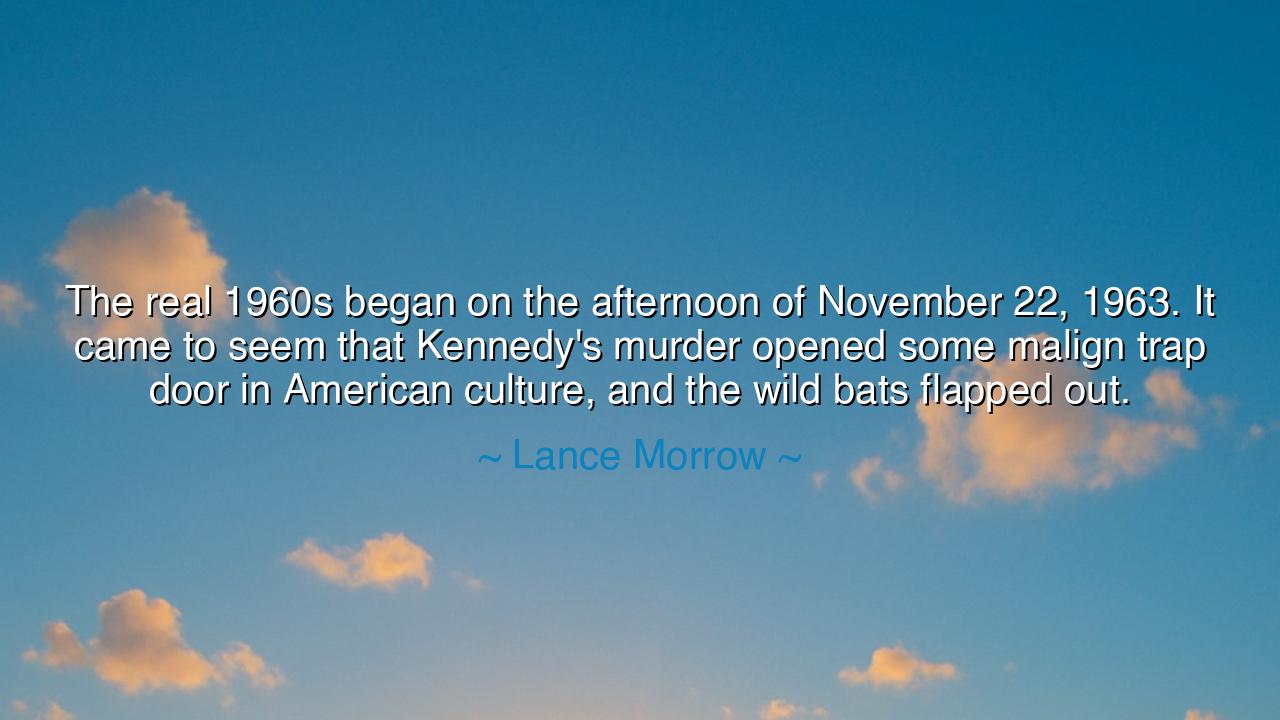
The real 1960s began on the afternoon of November 22, 1963. It
The real 1960s began on the afternoon of November 22, 1963. It came to seem that Kennedy's murder opened some malign trap door in American culture, and the wild bats flapped out.






“The real 1960s began on the afternoon of November 22, 1963. It came to seem that Kennedy’s murder opened some malign trap door in American culture, and the wild bats flapped out.” Thus wrote Lance Morrow, the essayist and historian of American moods, whose words capture not only an event but an awakening — or rather, an unmasking. For in this single sentence lies the story of a nation’s lost innocence: the moment when the shimmering dream of postwar optimism fell away, revealing the chaos and disillusionment beneath. The assassination of President John F. Kennedy, on that bright November afternoon in Dallas, did not merely end a life; it shattered a myth, and with it, the fragile illusion of an age at peace with itself.
When Morrow says that “the real 1960s began” on that day, he speaks not of the decade measured by calendar years, but of a spiritual turning — the moment when America crossed the threshold from confidence to confusion, from order to upheaval. Before the shot rang out in Dealey Plaza, the nation had walked in a kind of golden haze. Kennedy’s youth, his eloquence, and his vision for a “New Frontier” had become symbols of possibility. The country, prosperous and proud, believed itself to be ascending — toward space, toward equality, toward a better tomorrow. But with that single act of violence, something malign was unleashed, something that had long waited beneath the surface. As Morrow so vividly puts it, “the wild bats flapped out” — the darkness that had been hidden began to swirl openly in the light.
This metaphor of a trap door opening in the American soul is no mere flourish. It reflects the collective trauma of a generation who watched their hope die on live television, who saw the promise of their brightest leader extinguished in blood. What followed was not only grief, but unraveling. From that wound came the tumult of the 1960s — the assassinations of Malcolm X, Martin Luther King Jr., and Robert Kennedy; the Vietnam War; the student revolts; the cultural revolutions that tore at the fabric of the old America. The decade that had begun in optimism ended in anguish, in riots, in cynicism. It was as if the death of one man had loosed the demons of doubt, and they flew unchecked across the land.
Yet Morrow’s insight reaches beyond history; it touches the eternal rhythm of civilizations. For every society builds its myths — golden ages of innocence, of moral clarity — and every myth must one day be broken. When that breaking comes, it feels like a curse, like “bats” flying from some hidden crypt. But such moments are also revelations. The darkness that bursts forth is not new; it is merely the truth long denied. The same pattern can be seen throughout time: the fall of Athens after the death of Pericles, the Roman Republic after Caesar’s murder, the shattering of Europe’s calm after the Great War. In every case, the loss of a guiding figure exposes the deeper fractures that had been quietly growing beneath the surface.
One may recall, too, the ancient story of Pandora’s box. When curiosity led her to open the forbidden vessel, all the world’s sorrows escaped into the air — disease, strife, madness. Yet at the very bottom of that box, one thing remained: hope. So it was with the “trap door” of Morrow’s America. Out flew the chaos of revolution and mistrust, but also new movements of conscience — the struggle for civil rights, the demand for equality, the birth of environmental and artistic awakenings. From the same darkness that devoured innocence arose the light of awareness. The tragedy of Kennedy’s death, like Pandora’s act, was both a curse and a catalyst.
Morrow’s words remind us that history does not move gently. It lurches, it breaks, it wounds. And yet, in those very breaks, a people learns who they are. The “wild bats” of violence, fear, and rebellion are not merely agents of destruction; they are the shadows that reveal what has been ignored. For only when a nation confronts its own darkness — its prejudice, its arrogance, its hidden despair — can it begin to heal and grow wise. The lesson of November 22, 1963, is that no progress is permanent unless it is purified by truth.
So, my children, remember this: every age has its trap door, and every heart carries its own hidden darkness. When tragedy strikes, when the illusions of peace fall apart, do not despair. Do not flee from the bats that rise in the night — face them, and you will find that they are not demons, but messengers. They remind us that beneath every loss lies the possibility of renewal. As Morrow teaches, the death of innocence is not the end of history, but its true beginning. For only after illusion dies can wisdom live.
Thus, the meaning of this quote is both mourning and awakening. History’s trap doors open when least expected, and through them we fall — but also rise, chastened and clearer-eyed. The lesson is not to fear the fall, but to use it. When chaos comes, when the wild bats of our age take flight, remember that light, too, was once born out of darkness. And in every nation, as in every soul, the journey toward truth begins only when the dream is broken.






AAdministratorAdministrator
Welcome, honored guests. Please leave a comment, we will respond soon